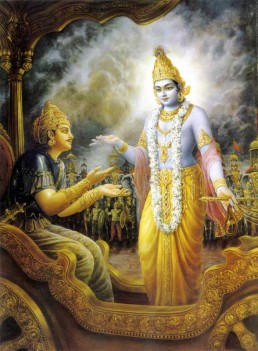Swami Chinmayananda Commentary
All along Krishna has been insisting that nobler actions are actions without attachment. This is easier said than done. Even if one intellectually accepts this idea, it is not at all easy for him to act up to it. To everyone of us the difficulty is that we know not how to get ourselves detached from our activities, and still act on in the field. The Lord gives here a method of discrimination by which we can easily develop the required amount of detachment.
We had explained earlier how spiritual IGNORANCE expresses itself at the intellectual level as DESIRES, which again, in the mental zone, manifests as THOUGHTS, and the very thoughts, coloured by our mental tendencies, manifest themselves, in their fulfilment in the outer world-of-objects, as our ACTIONS. Thus, the tendencies of the mind (vasanas) express in the outerworld as actions. Where there are noble-thoughts, there, noble-actions manifest. When the thoughts are agitated, the actions also are uncertain, faltering, and confused. And where the thoughts are dull and animalistic, the actions generated from them are also correspondingly base, vicious, and cruel. Thus, the mind’s projections in the outer-world are in fact a kind of crystallisation of the mental Vasana among the objects of the world and these constitute the “actions.”
Where there is a mind, there actions also must be performed. These actions are therefore GENERATED by the mind, STRENGTHENED in the mind and ultimately PERFORMED with the mind. But the individual, due to his wrong identification with his own mind, gets the false notion that he himself is the “actor” — the “doer.” This action-arrogating-ego naturally starts feeling an anxiety for its success and a burning attachment for the result of its actions.
In a dream, we create a world of our own and we identify ourselves with the world so made, and this IDENTIFIER is called the ‘dreamer.’ We all know that the sorrows of the dream all belong to the ‘dreamer’ and to no one else. The ‘dreamer’ is liberated from his pains when he ends his identification with the dream kingdom. Similarly, the actions in the world outside, which are nothing other than the vasanas existing in one’s own mind, cannot of themselves give one any attachment, but the attachment is felt by one who gets identified with one’s own mental conditions. The moment one understands this simple fact, all one’s attachments end, and therefore, one lives in perfect peace.
This identification with the mental condition creates the false sense of ego which arrogates to itself the idea: “I am the doer.” The “doer” demands the FRUITS OF HIS ACTION. To get over this attachment is to end this misconception.
BUT AS REGARDS THE ‘WISE’ MAN:
Adi Sankara Commentary
Karmani kriyamanani, while actions, secular and scriptural, are being done; sarvasah, in ever way; gunaih, by the gunas, (i.e.) by the modifications in the form of body and organs; (born) prakrteh, of Nature-Nature, (otherwise known as) Pradhana [Pradhana, Maya, the Power of God.], being the state of equilibrium of the three qualities of sattva, rajas and tamas; ahankara-vimudha-atma, one who is deluded by egoism; manyate, thinks; iti, thus; ‘Aham karta, I am the doer.’ Ahankara is self-identification with the aggregate of body and organs. He whose atma, mind, is vimudham, diluded in diverse ways, by that (ahankara) is ahankara-vimudha-atma. He who imagines the characteristics of the body and organs to be his own, who has self-identification with the body and the organs, and who, through ignorance, believes the activities to be his own-, he thinks, ‘I am the doer of those diverse activities.’
The Bhagavad Gita with the commentary of Sri Sankaracharya – Translated by Alladi Mahadeva Sastry
Holy Geeta – Commentary by Swami Chinmayananda
The Bhagavad Gita by Eknath Easwaran – Best selling translation of the Bhagavad Gita
The Bhagavad Gita – Translation and Commentary by Swami Sivananda
Bhagavad Gita – Translation and Commentary by Bhaktivedanta Swami Prabupadha
Srimad Bhagavad Gita Chapter 3 – Verse 27 – 3.27 prakriteh kriyamanani – All Bhagavad Gita (Geeta) Verses in Sanskrit, English, Transliteration, Word Meaning, Translation, Audio, Shankara Bhashya, Adi Sankaracharya Commentary and Links to Videos by Swami Chinmayananda and others – 3-27

